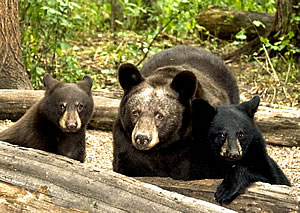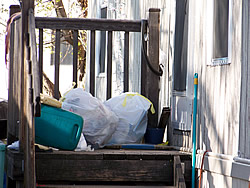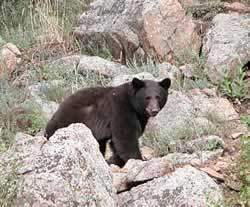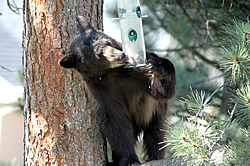Help Keep Bears Wild
 Black bears have lived in the foothills and forests of Colorado since long before the pioneers arrived. Today black bears are trying to share space with an ever-growing human population. With many more people living and playing in bear country, human-bear encounters are on the rise.
Black bears have lived in the foothills and forests of Colorado since long before the pioneers arrived. Today black bears are trying to share space with an ever-growing human population. With many more people living and playing in bear country, human-bear encounters are on the rise.
Bearproof your home (and your life)
Get in the habit of being bear-responsible. It’s like recycling — at first it’s a little extra effort, but soon it becomes a better way to live. You can be proud you’re helping to make Colorado a better place for people and bears.
- Don’t feed bears, and don’t put out food for other wildlife that attracts bears.
- Be responsible about trash and bird feeders.

- Burn food off barbeque grills and clean after each use.
- Keep all bear-accessible windows and doors closed and locked, including home, garage and vehicle doors.
- Don’t leave food, trash, coolers, air fresheners or anything that smells in your vehicle.
- Pick fruit before it ripens, and clean up fallen fruit.
- Talk to your neighbors about doing their part to be bear responsible.
If You See a bear near your home
If a bear comes near your home, do your best to chase it away. Yell, blow a whistle, clap your hands, and make other loud noises. But never approach a bear.
Only people (like you) can prevent problems with bears
Black bears are curious, smart and very adaptable. They’re not fussy and will eat just about anything with calories. Bears want to get the most energy they can with the least amount of effort. Every bear’s goal is to get fat enough to live through the winter.
Bear Calorie Counter
- Bird seed (7 lbs) = 12,180 calories
- Dog Food (25 lbs) = 42,425 calories
- Peanut Butter (28 oz) = 4,750 calories
- Shortening (3 lbs) = 12,430 calories
- Berries (1 lb) = 2,000 calories
Most conflicts between people and bears can be traced to easy-to-get-at human food, garbage, pet food, bird seed or other attractants.
When people allow bears to find food, a bear’s natural drive to eat can overcome its wariness of humans.
Bears that get too comfortable around people can destroy property or even become a threat to human safety. Habituated bears must often be destroyed. Please don’t let bears die needlessly. Do your part to bear-proof your home and property, and help keep bears alive and wild.
Garbage kills bears
Much of what people throw away smells like food to a hungry bear. Standard metal or plastic trash cans won’t keep out bears. Once bears learn where it’s easy to get at the garbage, they’ll come back again and again.
Never leave trash or recyclables out overnight. Empty cans and boxes still smell like food. One study showed that simply putting trash out only on the morning of pick up cuts the chances of a bear visit from 70% to 2%.
If you must leave trash outside, buy a bear-proof container, build a bear-proof enclosure or install an electric fence. To avoid attracting bears, clean containers regularly with ammonia or bleach.
Bears that learn garbage = food sometimes come inside homes looking for more.
Don’t make it easy for bears to visit;
keep bear-accessible windows and doors in your home and garage locked.
Bird feeders kill bears
Studies show that often the first reward a bear gets for exploring human places is a big meal of tasty, nutritious seeds (a natural food for bears). Letting your bird feeders turn into bear feeders teaches bears that coming close to people and homes looking for food is a good idea. For bears, that can end up being a deadly lesson.
 We recommend not feeding birds during the months when bears are active.
We recommend not feeding birds during the months when bears are active.
Instead, use water features, plantings, nest boxes and flowers to attract birds. Use bird feeders only when bears are hibernating.
If you don’t want to stop feeding birds, hang your feeders at least 10 feet off the ground and 10 feet away from anything bears can climb.
Keep the area underneath feeders clean and free of bird seed and hulls, or switch to a hulled bird seed with no waste.
Never store bird seed outside, under your deck, or in a garage or shed a bear could break into. A 50-pound bag of bird seed has over 87,000 calories—a reward for the bear that is well worth the effort of breaking in.
See the Bears and Bird Feeders: What You Need to Know (pdf) brochure, which contains an easy checklist, hibernation information, how to attract birds not bears and when to remove feeders if bears are causing problems.

